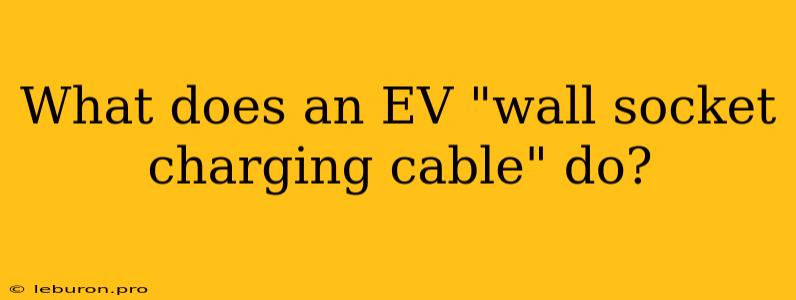What Does an EV "Wall Socket Charging Cable" Do?
Electric vehicles (EVs) are becoming increasingly popular, and with that popularity comes a need for convenient and efficient charging solutions. One common option is the wall socket charging cable, a versatile tool that allows you to charge your EV at home using a standard household outlet. But what exactly does this cable do, and how does it work?
This article delves into the intricacies of wall socket charging cables for EVs, explaining their functionality, advantages, and limitations. We will also discuss different types of cables, safety considerations, and factors to consider when choosing the right cable for your needs.
Understanding the Fundamentals of EV Charging
Before exploring the specifics of wall socket charging cables, it's essential to understand the basic principles of EV charging. EVs typically use a DC fast charging system, where direct current is supplied to the battery. However, household outlets provide alternating current (AC). Therefore, a wall socket charging cable includes an onboard AC-to-DC converter, also known as an on-board charger (OBC), which transforms the AC electricity from the outlet into the DC electricity needed for charging the EV battery.
How Wall Socket Charging Cables Work
Wall socket charging cables are designed to connect your EV to a standard household outlet. The cable itself contains a plug that fits into the outlet and a connector that connects to the EV's charging port. The charging process begins when you plug the cable into both the outlet and your EV's charging port.
The cable then transmits electricity from the outlet to the EV's onboard charger. This charger converts the AC electricity into DC electricity, which then flows into the EV's battery. The charging rate is determined by the amperage of the outlet and the capacity of the onboard charger.
Types of Wall Socket Charging Cables
Wall socket charging cables come in different types, each with its own specifications and capabilities.
- Level 1 Charging: This type of cable utilizes a standard 120-volt household outlet and provides the slowest charging rate. It's ideal for overnight charging or for those who only need a small charge boost.
- Level 2 Charging: These cables use a 240-volt outlet, such as those used for appliances like dryers and ovens. This results in a significantly faster charging rate than Level 1 charging.
Advantages of Wall Socket Charging
Wall socket charging cables offer several benefits:
- Convenience: They allow you to charge your EV at home, eliminating the need to visit public charging stations.
- Cost-effectiveness: Charging at home using a wall socket charging cable is generally cheaper than using public charging stations.
- Flexibility: You can charge your EV anytime and anywhere you have access to a standard outlet.
Limitations of Wall Socket Charging
Wall socket charging cables also have some drawbacks:
- Slow Charging: Level 1 charging can take a long time to fully charge an EV battery.
- Limited Range: Charging with a standard outlet may not provide enough range for long trips.
Safety Considerations for Wall Socket Charging
Wall socket charging cables are generally safe to use, but it's important to follow some safety guidelines to avoid potential hazards:
- Use the Correct Cable: Ensure you use the right type of cable for your EV and the available outlet.
- Inspect the Cable Regularly: Look for any damage or wear on the cable, plug, or connector.
- Avoid Overloading the Circuit: Be mindful of the amperage of the outlet and avoid overloading it.
- Never Use Damaged Cables: Replace any damaged cables immediately.
Choosing the Right Wall Socket Charging Cable
Selecting the right wall socket charging cable is crucial for optimal charging and safety. Consider these factors:
- EV Compatibility: Make sure the cable is compatible with your EV model.
- Charging Speed: Determine your charging needs and select a cable that provides the appropriate charging rate.
- Cable Length: Choose a cable with sufficient length for convenient charging.
- Durability: Opt for a cable made of high-quality materials to ensure durability and longevity.
Conclusion
Wall socket charging cables provide a convenient and cost-effective way to charge your EV at home. They are a valuable tool for EV owners who want to avoid the hassle of public charging stations. However, it's essential to choose the right cable for your needs, follow safety guidelines, and understand the limitations of this type of charging. By carefully considering these factors, you can make informed decisions regarding your EV charging needs and enjoy the benefits of convenient and efficient home charging.
